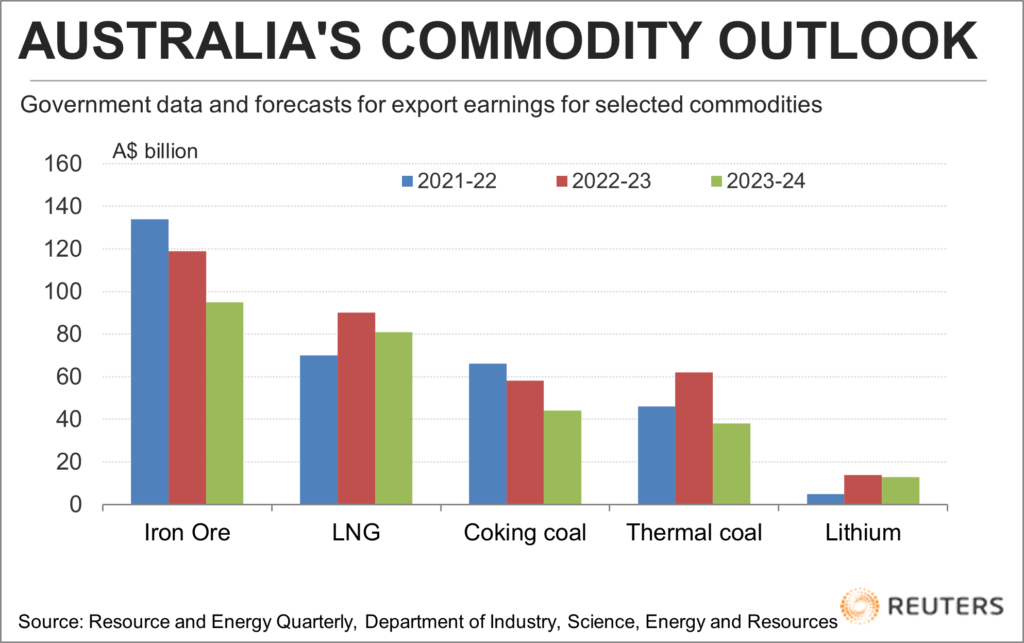
Australia expects a boost to its commodity export earnings caused by Russia’s invasion of Ukraine to last into 2024, upping its forecasts for both the current and following year.
The Australian government’s commodity forecaster said in its latest quarterly report released on Tuesday that export earnings would rise to a record A$450 billion ($293 billion) in the 2022-23 fiscal year that started on July 1.
This was up from A$419 billion in its previous report and will eclipse the prior record of A$421.6 billion in the year just ended on June 30, which was itself up 37% on the export revenue from the 2020-21 fiscal year.
For 2023-24, export earnings were pegged at A$375.5 billion, up from A$338 billion in the previous report.
Australia is the world’s largest exporter of iron ore, coking coal, liquefied natural gas (LNG) and lithium, while it ranks second in thermal coal and third in gold and in copper ores and concentrates.
The forecast for fresh record export earnings in the current year was, however, tempered with an assessment that downside risks have risen since the last quarterly outlook in July.
“Downside risks are substantial,” the Office of the Chief Economist at the Department of Industry, Science and Resources said in the report.
These include inflation proving harder to reduce than expected, tighter global financial conditions inducing debt distress in emerging market and developing economies, renewed covid-19 outbreaks and lingering problems in the Chinese property sector, the report stated.
Some risks could also provide upside for Australia’s exports, such as Russia cutting off gas exports to Europe.
The report noted that some of Russia’s exports of crude oil, coal and natural gas becoming stranded as European sanctions in imports start to take full effect from December this year.
It’s likely that not all of Russia’s commodity exports can be re-routed to other buyers such as China and India, thereby reducing overall global supply and keeping prices elevated.
This can be seen in the report’s forecast that LNG export earnings will jump to A$90 billion in 2022-23, up 29% from the prior fiscal year, even though volumes are expected to drop to 80 million tonnes of the super-chilled fuel from 2021-22’s 83 million.
The other big winner on the energy front is thermal coal, used mainly in power plants, with the government forecasting that 2022-23 export earnings will be A$62 billion, up 35% on the prior year.
But thermal coal also shows that the global market is likely to have worked through the Russia disruptions by the 2023-24 fiscal year, with the report forecasting export earnings will drop to A$38 billion, down 38.7% from what’s expected in the current year.

The government also expects that the current high prices for energy commodities will drive a faster transition to renewable energy.
Export earnings from lithium, a key component in batteries, are expected to jump 182% to A$13.8 billion in 2022-23, with the price more than doubling and shipments also gaining 15% to 2,609 tonnes.
Other metals that are viewed as essential to the energy transition are also expected to post robust gains in earnings, with nickel exports slated to reach A$5.1 billion in 2022-23, up from A$4.4 billion in 2021-22, while copper exports forecast at A$14 billion, up from A$12 billion.
Amid the strong earnings forecast for energy exports, both fossil and renewable, there is a note of caution, and that’s the lower revenue expected from iron ore, and also coking coal, the fuel used to turn the ore into crude steel.
Iron ore is Australia’s top resources export, but the government expects revenue to drop to A$119 billion in 2022-23 from A$134 billion in 2021-22, even though volumes are expected to rise to 903 million tonnes from 875 million.
A drop in the expected price to average $97 a tonne in 2022-23 from $119 in 2021-22 is the culprit, and the risk is that even the lower price forecast is optimistic and reliant on Beijing successfully stimulating steel-intensive sectors such as construction.
Coking coal export revenue is forecast to drop to A$58 billion in 2022-23 from A$66 billion in the prior year, even as volumes rise to 174 million tonnes from 162 million.
(The opinions expressed here are those of the author, Clyde Russell, a columnist for Reuters.)
(Editing by Richard Pullin)
Comments